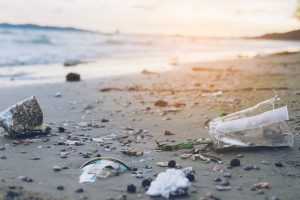
This Plastic Free July, we’re launching a blog series to dig more deeply into the story – and impacts – of plastics in Canada. But in order to tell the whole story, we need to zoom out and take a look at the big picture. Throughout the month of July, we’ll take you on a step-by-step journey that exposes the true cost of the plastic lifecycle, from the extraction of oil and gas all the way to the landfill…and beyond. In this blog, we’ll provide an overview of what’s to come in the month ahead.
What is Plastic Pollution?
What is plastic pollution, really? You may think you know the answer, but the true story of plastic in Canada might surprise you.
When most people think about the plastic pollution crisis, they imagine plastic-littered shorelines, floating plastic debris in the ocean, and mountains of plastic trash in landfills. But it’s so much more than that. The problem with plastic goes beyond litter and landfills.
The harm begins long before a plastic item is even made, and continues long after we throw the item away. Plastic pollution affects everything from air quality, to climate change to human health. Some of this pollution is hard to see with the naked eye, but it’s all part of the destructive cycle of plastic.
How Does Plastic Pollution Affect the Environment and Human Health?
Plastic pollution in all its many forms weighs heavily on the environment and human health. Plastic is in the air we breathe, the water we drink and the food we eat. We’re all in almost constant contact with it, but some communities bear the burden of plastic pollution more than others.
This series explores the full lifecycle of plastics and how it affects the environment and the people living in Canada’s plastic pollution hotspots along the way. Each blog will examine one part of the plastic lifecycle. Stay tuned, for all these stops we’ll be making on this polluting journey (starting next week!):
- Part 1: Extraction of oil and gas. We’ll begin in Canada’s tar sands in Alberta’s Athabasca region, where heavy oil is extracted. The pollution caused by this process is poisoning the water and environment of Indigenous peoples whose ancestors have lived on the water and land there since time immemorial. The dirty oil mined in the Athabasca is used to make petrochemicals, which are the building blocks of the plastic items we use every day, including water bottles.
- Part 2: Pipelines. Next, we’ll take a disturbing trip down Enbridge’s Line 5 pipeline which transports oil mined in Alberta to refineries in eastern Canada. Indigenous leaders and environmentalists have called for the shutdown of the old and deteriorating pipeline because of the dangers it poses to the environment and sacred places in the Great Lakes.
- Part 3: Refining and plastic production. At the end of the pipeline lies Canada’s Chemical Valley—a cluster of refineries in southwestern Ontario that make plastics and petrochemicals. Release of pollutants, including the carcinogen benzene, into the air and water, is affecting the health of the people of Aamjiwnaang and Sarnia,. Workers in plastics manufacturing are also exposed to toxic chemicals that pose a hazard to their health.
- Part 4: Microplastics. Once we’ve left the plastic refinery, we’ll be looking at the amount of plastic that immediately starts leaking into the environment from plastic shipments, products and waste in the form of pellets, flakes, fragments and fibres. Microplastics – particles of 5 millimetres or less – are transported long distances in air and water, and contaminate food webs and water supplies in even the most remote communities, including the Arctic.
- Part 5: Waste. Finally, we’ll arrive at the plastic pollution that is all too familiar to everyone. More than 4 million tonnes of plastic waste is generated in Canada every year, which mostly ends up in landfills or incinerators. These facilities generate pollution, including dust and air emissions, that can cause harm to nearby communities. The landfill for the City of Toronto is located next to two Indigenous communities – the Oneida Nation of the Thames and the Chippewa of the Thames – more than 200 kilometres southwest of the city where the waste is thrown away.
How Can We Stop Plastic Pollution?
Ending plastic pollution – starting by reducing how much plastic is made and used – would bring relief to communities who face the greatest hazards from it. We need to do it for ourselves and our neighbours near and far, for wildlife and all of the natural world. Throughout July, we’ll be exploring how we can achieve this, and what you can do to help.
Governments must:
- Clean up toxic tailings
- Shut down the Line 5 pipeline
- Ban more unnecessary and harmful single-use plastics
- Invest in reuse and refill as an alternative
- Commit to ending subsidies for plastic and oil production
- Ensure a just transition away from the polluting oil, gas and petrochemical economy.
The post The Story of Plastic in Canada – Introduction: Plastic Pollution Goes beyond the Landfill appeared first on Environmental Defence.
This post was originally published on Environmental Defence.